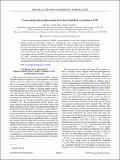Large and persistent photoconductivity due to hole-hole correlation in CdS
Author(s)
Yin, Han; Akey, Austin J; Jaramillo, Rafael
DownloadPhysRevMaterials.2.084602.pdf (1.528Mb)
PUBLISHER_POLICY
Publisher Policy
Article is made available in accordance with the publisher's policy and may be subject to US copyright law. Please refer to the publisher's site for terms of use.
Terms of use
Metadata
Show full item recordAbstract
Large and persistent photoconductivity (LPPC) in semiconductors is due to the trapping of photogenerated minority carriers at crystal defects. Theory has suggested that anion vacancies in II-VI semiconductors are responsible for LPPC due to negative-U behavior, whereby two minority carriers become kinetically trapped by lattice relaxation following photoexcitation. By performing a detailed analysis of photoconductivity in CdS, we provide experimental support for this negative-U model of LPPC. We also show that LPPC is correlated with sulfur deficiency. We use this understanding to vary the photoconductivity of CdS films over nine orders of magnitude, and vary the LPPC characteristic decay time from seconds to 10⁴s by controlling the activities of Cd²⁺ and S²⁻ ions during chemical bath deposition. We suggest a screening method to identify other materials with long-lived, nonequilibrium, photoexcited states based on the results of ground-state calculations of atomic rearrangements following defect redox reactions, with a conceptual connection to polaron formation.
Date issued
2018-08Department
Massachusetts Institute of Technology. Department of Materials Science and Engineering; Massachusetts Institute of Technology. Department of Mechanical EngineeringJournal
Physical Review Materials
Publisher
American Physical Society
Citation
Yin, Han et al. "Large and persistent photoconductivity due to hole-hole correlation in CdS." Physical Review Materials 2, 8 (August 2018): 084602 © 2018 American Physical Society
Version: Final published version
ISSN
2475-9953